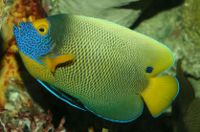Difference between revisions of "Pomacanthus xanthometopon"
From The Aquarium Wiki
(→External links) |
|||
| Line 79: | Line 79: | ||
*[http://www.aquaticcommunity.com/marinefish/pomacanthus-xanthometopo.php Aquatic Community] | *[http://www.aquaticcommunity.com/marinefish/pomacanthus-xanthometopo.php Aquatic Community] | ||
*[http://www.saltwaterfish.com/site_11_03/Blueface-Angelfish--A-_1373_4_61_64.html Saltwater Fish.com] | *[http://www.saltwaterfish.com/site_11_03/Blueface-Angelfish--A-_1373_4_61_64.html Saltwater Fish.com] | ||
| + | *[https://connectfishfriends.com/livestock-details/blueface-angelfish Connect Fish Friends] | ||
Latest revision as of 00:07, 26 October 2023
Blueface Angelfish
Pomacanthus xanthometopon
681 Litres (180 US G.)
33-38.1cm (13-15 ")
8.1 - 8.4
22.2-25.6°C (72 -78 °F)
8-12 °d
1:1 M:F
5-12 years
Family
Pomacanthidae
Contents
Additional names
- Yellowface, Yellowmask Angelfish, Yellowface Angelfish, Blue-Faced Angelfish
Additional scientific names
- Euxiphipops xanthometopon, Holacanthus xanthometopon
Sexing[edit]
- It is very difficult to visually sex this fish and it is not bred in captivity.
Tank compatibility[edit]
- It is best to keep only one Angelfish to a tank, these fish become quite territorial as they grow. This Angel is also not reef safe as it will nip at coral and clam mantles. Should be kept with similar-sized robust fish only.
Diet[edit]
- The diet should consist of spirulina, marine algae, high-quality angelfish preparations, mysis or frozen shrimp, and other meaty items.
Feeding regime[edit]
- Feed two to three times a day.
Environment specifics[edit]
- This fish requires a large and mature tank over 379 Litres (100 US G.). It requires a substantial amount of secure live rock with hiding places and grazing opportunities.
Behaviour[edit]
- A large-growing Angelfish that will graze live rock for algae. It is known to be territorial if its the largest fish in the tank.
Identification[edit]
- As a juvenile, the body is covered with alternating vertical stripes of black, white, and sapphire blue. Upon growing to approximately 12.7cm (5"), the juvenile begins to morph into its adult colouration of pale yellow with bluish scales and a bright-yellow pectoral fin. It has a mottled-blue face with yellow mask that extends from eye to eye but not much beyond each eye. There is also an eyespot at the caudal end of the dorsal fin.
Pictures[edit]
External links[edit]
- Fishbase (Mirrors:
 )
)

